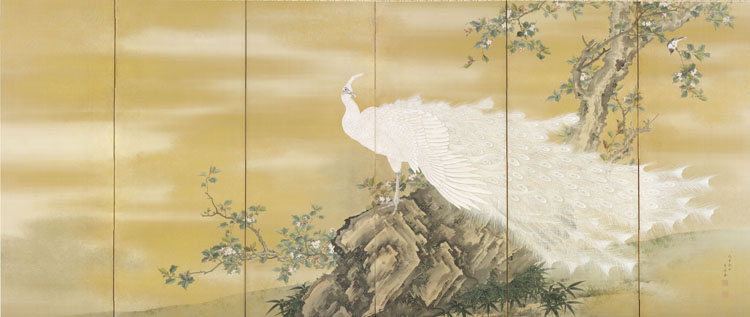A rare depiction of mynah birds in the exhibition also lends itself to interesting interpretation. According to John Carpenter, “If you’re doing a painting of mynah birds, it means that you’re talking about someone who is resisting authority or is resisting one’s sense of intellectual righteousness or honesty, and so to do an entire screen of mynah birds—you’re probably thinking about that.”
The two early 17th-century screens depicting a flock of more than 120 mynah birds in flight or strutting on the shore with very determined, almost-human expressions were painted at the time the Tokugawa warlords were usurping the power of the palace and the ancient capital of Kyoto.
In cases where the meaning is not that obvious, the exhibition features haiku and other poetry to stir the imagination.
In a kyoka (comic verse), the popular 18th-century poet Zeniya no Kinrachi writes:
It’s a lesson to you
That even the skylark
Soaring in the heavens
Comes down to earth
When night falls.
Though Japanese painting has its roots in China, it is unmistakable in its use of great expanses of blocked-out background, be it golden clouds, mist, or topographical features, coupled with depictions in full detail the delicacy of foreground subjects.
“This kind of composition, the abstraction of nature, the way the pine trees are depicted is very distinctly Japanese,” John Carpenter said.
The golden background often seen in larger screens is also “a symbol of the transcendental realm of Buddha,” Mr. Carpenter continued. “It is a color that’s always been associated with magic, with mystery in East Asian art.
“On a very material level, the gold is representing ostentation, power, and wealth of the people who commissioned [the work]. On another level, the gold clouds—it’s a signal that you’ve entered a fantasy world, an idyllic time in the past, or a time that stands outside of history,” he said.
Some of the works are large enough to create their own space while others invite one to observe and savor every detail in silent contemplation.
“The idea of the mind having [a] contemplative mode is actually related to the use of blank space in Japanese painting,” said Mr. Carpenter, explaining further that the use of blank space in contrast with the ink painting is related to the religious painting tradition where meditation was at the core of religious practice.













